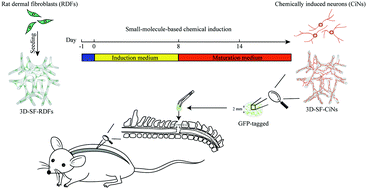Transplantation of neural scaffolds consisting of dermal fibroblast-reprogrammed neurons and 3D silk fibrous materials promotes the repair of spinal cord injury†
Abstract
Transplantation of tissue-engineered neural scaffolds bears great potential for reconstructing neural circuits after spinal cord injury (SCI). In this study, a 3D porous silk fibrous scaffold (3D-SF) with biomimetic interconnected micro- to nanofibrous structure and good biocompatibility is fabricated. Then, a small-molecule combination CFLSSVY (CHIR99021, Forskolin, LDN193189, SB431542, SP600125, VPA, and Y27632) that efficiently reprograms rat dermal fibroblasts into neurons is screened, and these chemically induced neurons (CiNs) are shown to readily communicate on the 3D-SF and form neural scaffolds. After transplantation of these silk-based neural scaffolds into the stumps of transected spinal cords in rats, the damaged tissue is repaired significantly, as indicated by the reduced cavity areas, decreased GFAP expression, and improved axonal regeneration and myelination in the injury site. Moreover, the hindlimb movement and motor-nerve conductivity are greatly improved as indicated by the elevated BBB score, the alternate movement of two hindlimbs during the 45° inclined grid test, and the shortened latency and enhanced amplitude in cMEP detection. Together, these results demonstrate that transplantation of neural scaffolds consisting of 3D-SF and dermal fibroblast-reprogrammed neurons leads to significant nerve regeneration and functional recovery, providing a promising therapeutic strategy for SCI.



 Please wait while we load your content...
Please wait while we load your content...